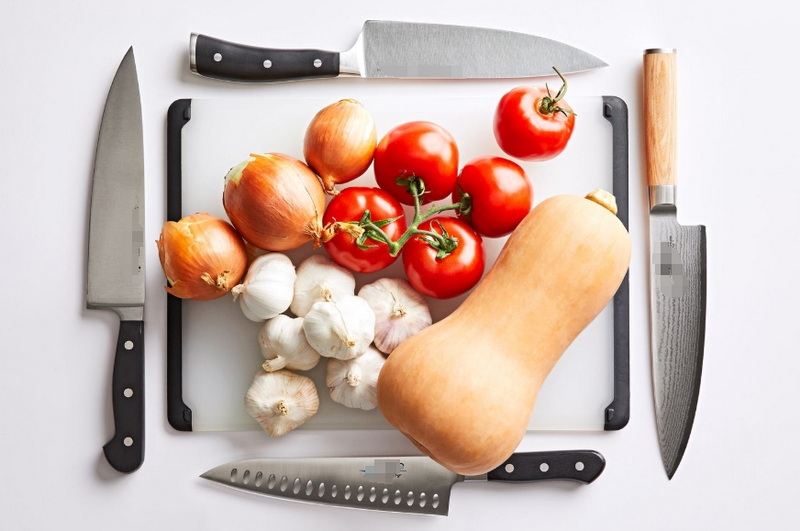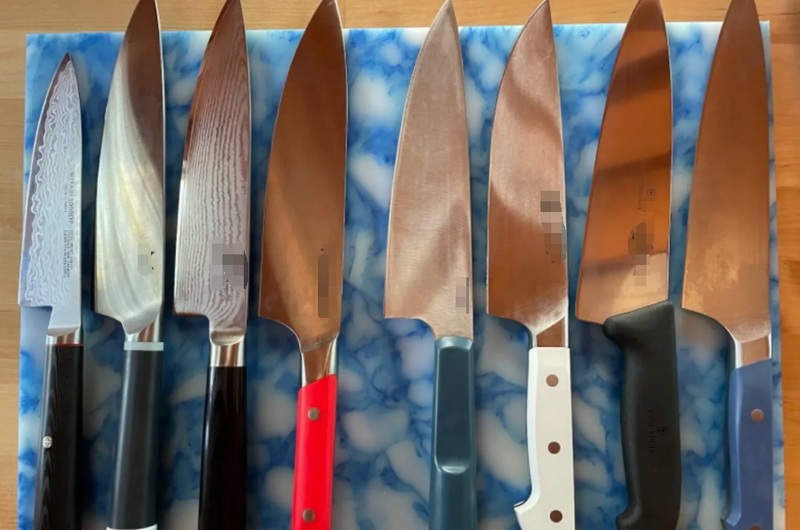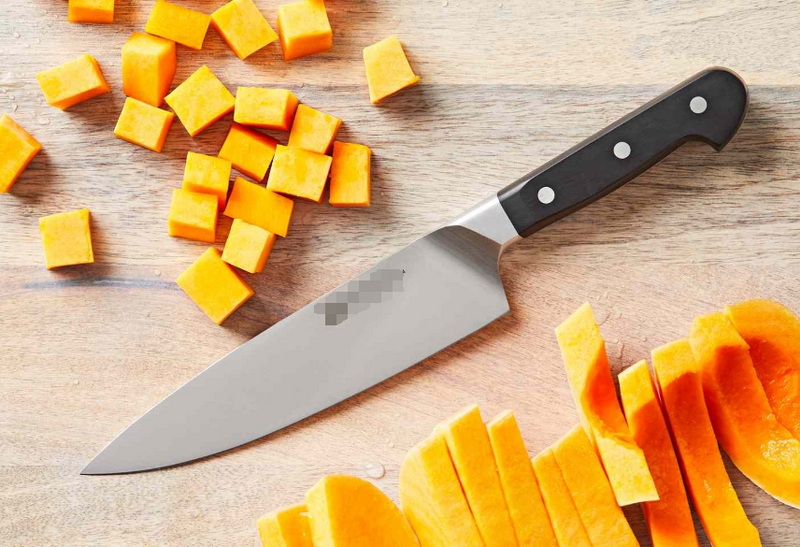

Views: 222 Author: Ella Publish Time: 2025-05-08 Origin: Site








Content Menu
● The Role of Weight in Chef Knives
● What Is the Ideal Weight for a Chef Knife?
● How Weight and Balance Affect Knife Performance
>> Blade-Heavy vs. Handle-Heavy vs. Even Balance
>> The Pinch Grip and Balance Point
● Factors Influencing the Ideal Knife Weight
>> 2. Cooking Style and Frequency
>> 3. Blade Length and Thickness
>> 4. Handle and Blade Materials
● How to Choose the Right Chef Knife Weight for You
>> Step 1: Test Different Weights
>> Step 2: Consider Your Cooking Habits
>> Step 3: Don't Forget Balance
>> Step 4: Think About Maintenance
● Exploring Knife Weight Through Different Cuisines
>> Western vs. Eastern Chef Knives
>> The Evolution of Chef Knife Design
● Ergonomics: Reducing Fatigue and Improving Comfort
>> Weight Distribution and Repetitive Strain
● Chef Knife Weight and Cutting Techniques
>> Chopping
>> Slicing
>> Push Cutting
● Caring for Your Chef Knife: Weight and Maintenance
>> Cleaning
>> Sharpening
>> Storage
● Chef Testimonials: Real-World Experiences
● The Science of Knife Weight: Materials and Technology
● The Psychological Impact of Knife Weight
● Frequently Asked Questions (FAQ)
>> 1. What is the average weight of an 8-inch chef knife?
>> 2. Is a heavier chef knife better for cutting meat?
>> 3. Are lighter chef knives safer to use?
>> 4. How does knife balance affect performance?
>> 5. What should I consider besides weight when choosing a chef knife?
A chef knife is the heart of any kitchen, whether you're a passionate home cook or a seasoned professional. Among the many factors that influence a knife's performance, weight is one of the most debated. Does a heavier knife make cutting easier, or does a lighter blade offer better control? How do weight and balance impact your cooking experience? In this comprehensive guide, we'll explore the ideal weight for a chef knife, the science behind weight and balance, and practical tips for choosing your perfect kitchen companion.

The weight of a chef knife directly affects how it feels in your hand and how it performs in the kitchen. This seemingly simple factor can make a significant difference in your cooking efficiency, comfort, and even safety.
A chef knife's weight determines how much force you need to apply during cutting. A heavier knife can power through dense foods with less effort, while a lighter knife offers more agility and control for delicate tasks.
- Heavier knives: These knives provide more momentum, making it easier to cut through tough ingredients like root vegetables, squash, or large cuts of meat. The additional weight can help the knife “do the work for you,” reducing the need for excessive force. However, they can cause fatigue during prolonged use or when performing intricate cuts.
- Lighter knives: These are preferred for their maneuverability and are ideal for precise, repetitive tasks such as mincing herbs, slicing soft fruits, or preparing garnishes. They are less tiring for long prep sessions but may require more effort to cut through dense foods.
Weight alone isn't everything-balance is just as important. A well-balanced knife feels natural, with weight distributed evenly between the handle and blade, making it comfortable for various cutting techniques. A balanced knife allows for more precise control and reduces the risk of strain or injury during extended use.
There isn't a universal “perfect” weight for a chef knife, as preferences vary based on hand size, strength, and cooking style. However, most 8-inch chef knives-the most popular size-typically weigh between 180g and 250g. Many cooks find this range offers the best compromise between power and control.
- 6-inch Chef Knife: Commonly weighs between 120g and 170g. This size is ideal for smaller hands or cooks who prefer a lightweight, nimble blade.
- 8-inch Chef Knife: Usually weighs between 180g and 250g. This is the standard size for most home and professional kitchens, offering a good balance of versatility and comfort.
- 10-inch Chef Knife: Often weighs 240g to 300g or more. These knives are favored by professionals who need to process large quantities of ingredients quickly.
- Home cooks: Often prefer lighter knives (180g–210g) for better control and less fatigue.
- Professional chefs: May choose heavier knives (220g–250g+) for increased cutting power and efficiency during long prep sessions.
Ultimately, the ideal weight is subjective. Some chefs prefer a heavier knife for the “falling through food” sensation, while others favor a lighter blade for nimble handling. The best approach is to try different weights and see what feels most comfortable for your hand and tasks.
- Blade-heavy knives: More weight toward the blade, ideal for chopping and dicing tough ingredients but can be tiring over time.
- Handle-heavy knives: Weight concentrated in the handle, offering better control for delicate or precise work.
- Evenly balanced knives: Weight distributed equally, making them versatile for most kitchen tasks and preferred by many cooks.
Most chef knives are designed with a balance point at the bolster (where the blade meets the handle), aligning with the pinch grip for maximum control and comfort. This grip allows for precise movements and reduces fatigue.
- Smaller hands: May find lighter knives easier to control.
- Larger hands: Can comfortably wield heavier knives, benefiting from the added momentum.
- Frequent, prolonged prep: A lighter, well-balanced knife reduces hand fatigue.
- Occasional, heavy-duty chopping: A heavier knife can make tough jobs easier.
Longer and thicker blades naturally weigh more. Choose a blade length that matches your typical cutting tasks-6-8 inches for most home cooks, 8-10 inches for professionals or those handling large ingredients.
- Handle material: Wood, plastic, and metal handles all affect the overall weight and balance.
- Blade material: High-carbon steel and stainless steel have different densities, impacting knife weight and performance.
- Full tang: A knife with a full tang (the metal of the blade extends through the handle) is generally heavier and more balanced.
- Partial tang: Lighter, but may feel less sturdy and balanced.
Visit a kitchen store and hold several knives. Practice the pinch grip and mimic your usual cutting motions. Notice how the knife feels-does it feel like an extension of your hand, or is it awkward and tiring?
If you spend hours prepping, a lighter, balanced knife may be best. If you often chop dense foods or want a knife that “does the work for you,” try a heavier blade.
Even a heavier knife can feel light if it's well-balanced. Focus on how the knife feels in motion, not just its weight.
Heavier knives may require more frequent sharpening due to the increased force applied during cutting. Lighter knives, especially those made from harder steel, may hold an edge longer but can be more prone to chipping if misused.

- Western chef knives (e.g., German, French): Tend to be heavier, with thicker blades and a pronounced curve for rocking motions.
- Eastern chef knives (e.g., Japanese Gyuto, Santoku): Are often lighter, with thinner blades and a straighter edge for push-cutting techniques.
- Japanese cuisine: Emphasizes precision and delicacy, favoring lighter, sharper knives for intricate work.
- Western cuisine: Often involves more robust chopping and slicing, making heavier knives more popular.
Knife makers have continually refined blade geometry, materials, and construction to suit different culinary traditions. Modern chef knives often blend features from both Western and Eastern styles, offering a range of weights and balances to suit any preference.
A comfortable handle is essential for reducing fatigue, especially during long prep sessions. Ergonomic handles are shaped to fit the natural contours of your hand, providing a secure grip and promoting proper technique.
A well-balanced knife reduces the risk of repetitive strain injuries by allowing your hand and wrist to move naturally. If you experience discomfort or fatigue, consider switching to a lighter or more ergonomically designed knife.
A heavier knife excels at chopping through dense ingredients, as the added weight helps drive the blade through food with minimal effort.
For thin, precise slices, a lighter knife offers better control and agility, allowing you to make clean cuts without crushing delicate ingredients.
Western-style chef knives with a curved blade and moderate weight are ideal for the rocking motion used in mincing herbs or garlic.
Japanese-style knives, which are lighter and have a straighter edge, excel at push cutting-a technique that produces clean, precise cuts with minimal effort.
Regardless of weight, always hand-wash your chef knife and dry it immediately to prevent rust and maintain sharpness.
Heavier knives may dull faster due to increased force during cutting. Regular honing and periodic sharpening will keep your knife performing at its best.
Store your knife in a block, on a magnetic strip, or in a sheath to protect the blade and maintain balance.
Many professional chefs emphasize the importance of finding a knife that feels right for your hand. Some prefer the heft and power of a heavier German-style knife, while others swear by the nimbleness of a lightweight Japanese blade.
Home cooks often appreciate lighter knives for everyday tasks, noting that they reduce fatigue and make cooking more enjoyable. However, many keep a heavier knife on hand for tackling large or tough ingredients.
- High-carbon steel: Heavier, holds a sharp edge well, but requires more maintenance.
- Stainless steel: Lighter, more resistant to corrosion, but may need more frequent sharpening.
- Powdered steel and composites: Offer a balance of weight, strength, and edge retention.
- Wood: Traditional, offers a warm feel but can add weight.
- Plastic or resin: Lightweight and durable, often used in modern designs.
- Metal: Adds significant weight, often used for balance in full-tang knives.
Knife manufacturers now use advanced materials and precision engineering to create blades that maximize performance while minimizing unnecessary weight. Hybrid designs allow cooks to enjoy the benefits of both Western and Eastern styles.
A knife that feels right in your hand boosts confidence and encourages proper technique. Whether you prefer a light, agile blade or a hefty, powerful one, the right weight can make cooking more enjoyable and less stressful.
Choosing a knife with the appropriate weight and balance for your hand size and cooking style can significantly reduce fatigue, allowing you to focus on creativity and precision in the kitchen.
The ideal weight for a chef knife is a personal choice, influenced by your hand size, strength, and cooking style. Most cooks find the sweet spot for an 8-inch chef knife between 180g and 250g, but the key is to choose a knife that feels comfortable, balanced, and efficient for your needs. Test different knives, pay attention to balance, and invest in a quality blade that will serve you for years to come. Remember, the right knife not only enhances your cooking but also makes every meal preparation a pleasure.

Most 8-inch chef knives weigh between 180g and 250g, providing a balance suitable for a wide range of kitchen tasks.
Yes, a heavier chef knife can make it easier to cut through dense meats and tough vegetables by adding momentum to your cuts. However, it may cause fatigue during prolonged use.
Lighter knives are often easier to control, making them safer for delicate tasks and for cooks with smaller hands. However, proper technique and a sharp blade are more important for safety than weight alone.
A well-balanced knife feels stable and comfortable, reducing fatigue and improving precision. Balance points vary: blade-heavy for power, handle-heavy for control, and even balance for versatility.
Consider blade length, handle comfort, blade material, and overall balance. The knife should feel like an extension of your hand and suit the types of food you prepare most often.